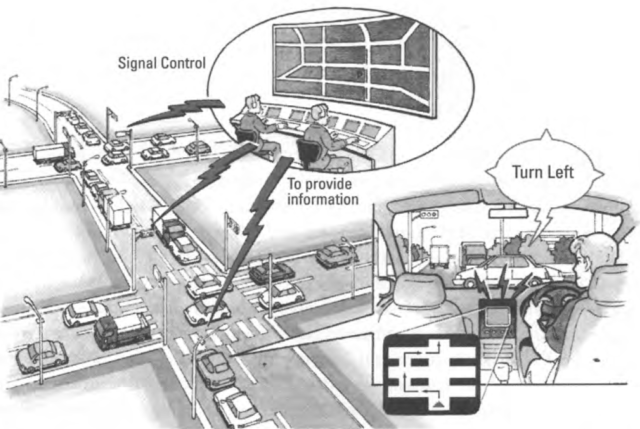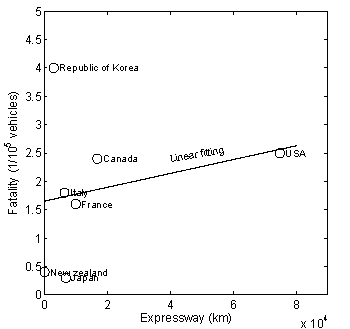A Coupling Of Information System And Transportation System
by Fergyanto E Gunawan (fgunawan@binus.edu)
Traffic congestion is one of many major issues faced by many mega-cities [1]. Traffic congestion adversely affects various aspects including economic, environment, and health. In Jakarta, for an example, traffic congestion costed the city about 3%--6% of the city gross domestic income, in 2009, according to the head of Indonesia Transportation Society [2].
The congestion occurs mainly due to imbalance between the traffic volume and the existing transportation system capacity; that is when the traffic volume is larger than the road capacity. Despite of that, a few scientists have recently found that the congestion may also occur when the traffic flow is lower than the road capacity. Such congestion is often called the phantom traffic jam [3, 4], and is likely to happen when a vehicle or more moving aggressively within a platoon of vehicles.
In a few countries, such as South Korea, the above congestion problem was lessened by deploying intelligent transportation systems (ITS). Essentially, the system is a combination of the transportation system and information technology. This combination allows us to firstly monitor the status of the existing transportation systems, and then, to manage the demand level such that the whole transportation systems can optimally operate. Therefore, ITS is basically a closed-looped system where information technology plays a role as a means for feedback mechanism and control.
Figure 1 shows an illustrative example of a potential use of ITS where the traffic management center continuously monitors the traffic volume on a road network. The monitoring is performed by means of traffic detectors installed across the network. When a jam is detected occurring on certain road segment, the traffic management center sends a signal to an approaching vehicle and recommends the vehicle to take another route. Hence, the number of vehicles approaches the congested road can be reduced. Finally, the congestion can be diminished.
 |
| Figure 1: An Example of Traffic Management System in Intelligent Transportation Systems [5] |
For another example, we consider the use of an electronic toll collection (ETC) system that capable to completely eliminate the traffic congestion ahead of a toll gate. When the gate is manually handled, the maximum transaction is about 600 vehicles per hour. The use of ETC can increase the transaction to 1400 vehicles per hour [6]. ETC system permits a vehicle to cross the toll gate at a reasonable speed without stopping and the toll fee is transferred electronically via two-way radio communication. ETC does not only solve the congestion problem, but also reduces noise and gas emission at the gate. In Japan, when the use of ETC reached 50% on October 2005, the system was estimated to reduce CO2 emission by 34% or about 130 thousand tons per year[7].
Beside Japan, South Korea also heavily relies on ITS to reduce the traffic congestion. Previously, South Korea was known with very high fatalities due to traffic accidents (see Fig. 2). However, the fatalities and traffic accident were quickly reduced after implementing ITS, and the traffic condition was improved significantly (see Table 1).
 |
| Figure 2: Fatalities due Traffic Accidents among OECD Countries [8] |
| Table 1: Effects of ITS in South Korea [8] | |||
| Impacts | Deajon | Jeanju | Jeju |
| Increase in travel speed | 19.3% | 35.6% | 6.1% |
| Decrease in delays | 53% | 31.5% | 31.9% |
| Increase in citizen's satisfaction | 27.3% | 22.9% | 22.3% |
This article has briefly illustrated the use of ITS to reduce traffic congestion. Those illustrations clearly show that ITS is a well-proven technology. ITS is the only system, arguably, that provides a means to optimize the existing transportation system.
References
- Shigeru Morichi, J. of the Eastern Asia Society for Trans. Studies, 6:1--22, 2005
- FE Gunawan and E. Kusnandar, Jurnal Jalan dan Jembatan, 28(2), 2011
- A. Nakayama et al., Traffic and Granular Flow 07, pages 389--394, Springer Berlin Heidelberg, 2009
- MR Flynn et al., URL http://math.mit.edu/projects/traffic/
- Kan Chen and John C. Miles, ITS Handbook 2000: Recommendations from the World Road Association (PIARC), Artech House, 1999
- JD Nelson et al., Transport Reviews, 21(1):51--74, 2001
- Miyata Toshitaka, Japan ITS Handbook 2006--2007, Highway Industry Development Organization, 2007
- AA Shah et al., WIT Transactions on the Built Environment, 89:763--772, 2006
Jakarta, May 2013
